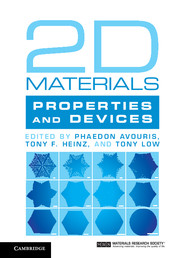Book contents
- 2D MaterialsProperties and Devices
- Reviews
- 2D Materials
- Copyright page
- Contents
- Contributors
- Introduction
- Part I
- 1 Graphene: Basic Properties
- 2 Electrical Transport in Graphene: Carrier Scattering by Impurities and Phonons
- 3 Optical Properties of Graphene
- 4 Graphene Mechanical Properties
- 5 Vibrations in Graphene
- 6 Thermal Properties of Graphene: From Physics to Applications
- 7 Graphene Plasmonics
- 8 Electron Optics with Graphene p–n Junctions
- 9 Graphene Electronics
- 10 Graphene: Optoelectronic Devices
- 11 Graphene Spintronics
- 12 Graphene–BN Heterostructures
- 13 Controlled Growth of Graphene Crystals by Chemical Vapor Deposition: From Solid Metals to Liquid Metals
- Part II
- Part III
- Index
- References
1 - Graphene: Basic Properties
from Part I
Published online by Cambridge University Press: 22 June 2017
- 2D MaterialsProperties and Devices
- Reviews
- 2D Materials
- Copyright page
- Contents
- Contributors
- Introduction
- Part I
- 1 Graphene: Basic Properties
- 2 Electrical Transport in Graphene: Carrier Scattering by Impurities and Phonons
- 3 Optical Properties of Graphene
- 4 Graphene Mechanical Properties
- 5 Vibrations in Graphene
- 6 Thermal Properties of Graphene: From Physics to Applications
- 7 Graphene Plasmonics
- 8 Electron Optics with Graphene p–n Junctions
- 9 Graphene Electronics
- 10 Graphene: Optoelectronic Devices
- 11 Graphene Spintronics
- 12 Graphene–BN Heterostructures
- 13 Controlled Growth of Graphene Crystals by Chemical Vapor Deposition: From Solid Metals to Liquid Metals
- Part II
- Part III
- Index
- References
- Type
- Chapter
- Information
- 2D MaterialsProperties and Devices, pp. 7 - 24Publisher: Cambridge University PressPrint publication year: 2017
References
1.6 References
- 2
- Cited by



